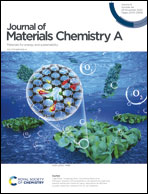Highly H2O permeable ionic liquid encapsulated metal–organic framework membranes for energy-efficient air-dehumidification†
Abstract
Isothermal membrane-based air dehumidification (IMAD) is much more energy-efficient and economical than traditional air-dehumidification technologies. There are, however, no practical IMAD process technologies currently available mainly due to limitations of current membranes. Ionic liquids (ILs) are a promising air-dehumidification membrane material. Current supported IL membranes suffer from poor stability, limiting their performances. Herein, we propose new stable IL membranes, encapsulated IL membranes (EILMs) by encapsulating 1-butyl-3-methylimidazolium bromide ([C4MIM][Br]) into ultrathin polycrystalline UiO-66-NH2 metal–organic framework membranes via a ship-in-a-bottle method. The stability of IL membranes is significantly enhanced due to the IL entrapped in the pore cages of UiO-66-NH2. The EILMs show unprecedentedly high H2O permeance (∼2.36 × 10−4 mol m−2 s−1 Pa−1), an order of magnitude greater than that of the most permeable air-dehumidification membranes reported so far. Furthermore, the encapsulated [C4MIM][Br] drastically increases the H2O/N2 separation factor to ∼1560, satisfying the minimally required H2O/N2 separation performance for commercially viable air-dehumidification.



 Please wait while we load your content...
Please wait while we load your content...